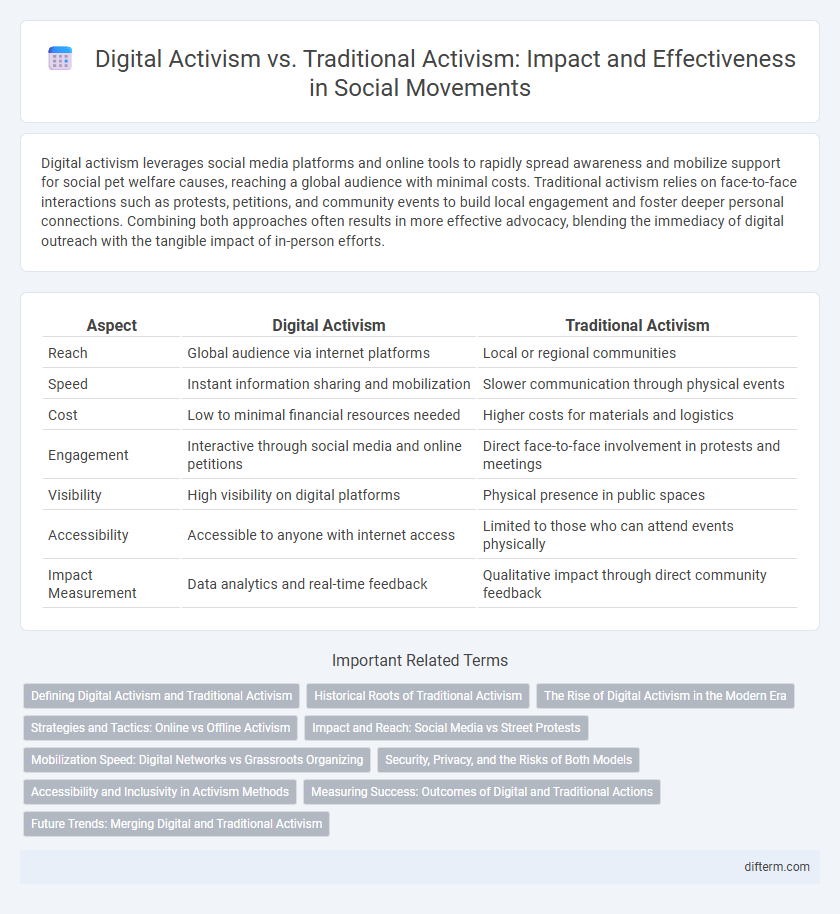Digital activism leverages social media platforms and online tools to rapidly spread awareness and mobilize support for social pet welfare causes, reaching a global audience with minimal costs. Traditional activism relies on face-to-face interactions such as protests, petitions, and community events to build local engagement and foster deeper personal connections. Combining both approaches often results in more effective advocacy, blending the immediacy of digital outreach with the tangible impact of in-person efforts.
Table of Comparison
| Aspect | Digital Activism | Traditional Activism |
|---|---|---|
| Reach | Global audience via internet platforms | Local or regional communities |
| Speed | Instant information sharing and mobilization | Slower communication through physical events |
| Cost | Low to minimal financial resources needed | Higher costs for materials and logistics |
| Engagement | Interactive through social media and online petitions | Direct face-to-face involvement in protests and meetings |
| Visibility | High visibility on digital platforms | Physical presence in public spaces |
| Accessibility | Accessible to anyone with internet access | Limited to those who can attend events physically |
| Impact Measurement | Data analytics and real-time feedback | Qualitative impact through direct community feedback |
Defining Digital Activism and Traditional Activism
Digital activism involves the use of online platforms, social media, and digital tools to mobilize, organize, and advocate for social or political causes, enabling rapid information dissemination and global reach. Traditional activism relies on physical presence through protests, rallies, and grassroots organizing to create change, emphasizing face-to-face interaction and community building. Both forms seek to influence public opinion and policy but operate through distinct channels and strategies tailored to their mediums.
Historical Roots of Traditional Activism
Traditional activism traces its historical roots to grassroots movements and mass protests dating back to the labor strikes of the late 19th century and civil rights campaigns of the 1960s. These movements emphasized physical presence, community organizing, and direct action as means to demand social change. The evolution of traditional activism laid the groundwork for collective mobilization and established frameworks still influential in contemporary social justice efforts.
The Rise of Digital Activism in the Modern Era
Digital activism has surged in the modern era, leveraging social media platforms like Twitter, Facebook, and Instagram to mobilize millions quickly and globally. Unlike traditional activism, which relies on physical presence and grassroots organizing, digital activism enables real-time communication, widespread awareness, and viral campaigns that transcend geographic boundaries. This shift has empowered movements such as #BlackLivesMatter and #MeToo, demonstrating the immense influence of online advocacy in shaping public discourse and policy change.
Strategies and Tactics: Online vs Offline Activism
Digital activism leverages social media platforms, hashtags, and online petitions to rapidly mobilize large audiences and amplify messages across global networks. Traditional activism relies on in-person tactics such as protests, sit-ins, and community meetings to build local solidarity and apply direct pressure on institutions. Both strategies deploy targeted communication and engagement methods, but digital activism emphasizes speed and scale, while offline activism focuses on physical presence and sustained grassroots organization.
Impact and Reach: Social Media vs Street Protests
Digital activism leverages social media platforms like Twitter, Instagram, and Facebook to rapidly disseminate information, mobilizing millions globally with hashtags and viral campaigns that transcend geographical barriers. Traditional activism, through street protests and physical demonstrations, offers immediate, tangible visibility and powerful emotional impact by engaging participants in real-world spaces and fostering community solidarity. While digital activism maximizes reach and speed, street protests provide crucial physical presence and media attention that can pressure policy change and raise localized awareness.
Mobilization Speed: Digital Networks vs Grassroots Organizing
Digital activism leverages social media platforms and online networks to mobilize supporters rapidly, enabling real-time communication and viral campaign dissemination. Traditional activism relies on grassroots organizing, which often involves in-person meetings, physical rallies, and local community engagement, resulting in slower but potentially more sustained mobilization. The speed of digital networks accelerates awareness and participation, while grassroots efforts build deeper, long-term commitment through direct interpersonal connections.
Security, Privacy, and the Risks of Both Models
Digital activism offers rapid mobilization and broad reach but faces significant risks related to cybersecurity threats, data breaches, and surveillance compromising user privacy. Traditional activism, while often more physically secure, involves risks such as exposure to legal consequences, physical harm, and infiltration by opposing groups. Both models require robust strategies to protect participants' identities and maintain operational security in increasingly complex threat environments.
Accessibility and Inclusivity in Activism Methods
Digital activism enhances accessibility by allowing widespread participation through online platforms, breaking geographical barriers and enabling marginalized groups to voice their concerns. Traditional activism often relies on physical presence, which can exclude individuals with mobility issues or time constraints, limiting inclusivity. By leveraging digital tools such as social media, petitions, and virtual events, activism becomes more inclusive, engaging diverse populations and fostering broader societal impact.
Measuring Success: Outcomes of Digital and Traditional Actions
Measuring success in digital activism involves analyzing online engagement metrics such as shares, hashtags, and petition signatures, which reflect rapid but sometimes ephemeral impact. Traditional activism success is often gauged through tangible outcomes like policy changes, sustained community organizing, and public demonstrations that result in long-term social change. Combining digital data analytics with real-world impact assessments provides a comprehensive understanding of activism effectiveness across platforms.
Future Trends: Merging Digital and Traditional Activism
Emerging future trends indicate a growing convergence between digital activism and traditional activism, leveraging social media platforms and localized grassroots efforts for amplified impact. Hybrid campaigns employing real-time data analytics and on-the-ground mobilization are increasingly effective in driving social change. This fusion maximizes reach and engagement by combining virtual advocacy with physical community organizing.
Digital Activism vs Traditional Activism Infographic

 difterm.com
difterm.com